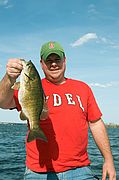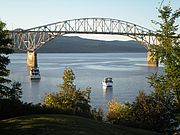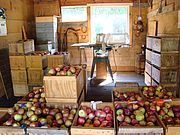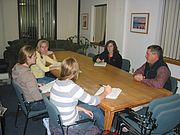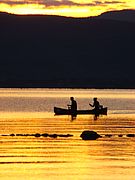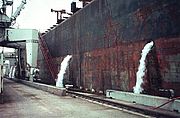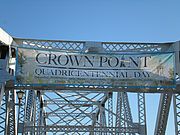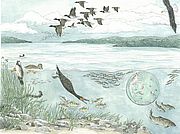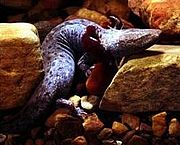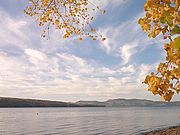Numerous bass fishing tournaments are held around the lake each year. A fish kill from a recent Plattsburgh event rekindled concerns about the number of fishing tournaments on the lake and raised questions about the impact to the bass fishery. To help guide discussions on this issue, the Lake Champlain Fisheries Leadership Institute Seminar Series is hosting a presentation by Dr. Bruce Tufts of Queen’s University in Ontario. Dr. Tufts is a recognized expert on Bass biology and catch and release fishing. The program is free and open to the public and will be held at the Cardinal Lounge at PSUNY’s Angell College Center. The program is sponsored by Lake Champlain Sea Grant, Great Lakes Research Consortium, and the Lake Champlain Research Institute. For more information contact timothy.mihuc@plattsburgh.edu at SUNY Plattsburgh’s Lake Champlain Research Institute or mark.malchoff@plattsburgh.edu at Sea Grant. Read...
News from Selected Month
New York Governor David A. Paterson and Vermont Governor Jim Douglas have received a report from their states' respective transportation agencies which finds that it is not feasible to rehabilitate the Champlain Bridge. Engineers have declared that the 80-year-old span is too unstable to be renovated, and recommend demolishing the bridge for the safety of motorists and boaters. The Federal Highway Administration is expected to concur with the recommendation based on their preliminary review of the report. Transportation officials anticipate building a new bridge as close as possible to the current location. Read...
As you go about your food preparations for Thanksgiving and other upcoming holidays, consider supporting local farmers. If you live in the Champlain Valley, finding eggs, butter, cheese, cream and milk and even poultry produced nearby is fairly easy regardless of the season. However, local beets, potatoes, onions, garlic, carrots, pumpkins, squash, apples and other staples are often available even into November and December. Providing a meal where most of the food comes from within a 30-mile radius of home can deepen the meaning of Thanksgiving.
According to the Vermont Department of Agriculture, shifting just 10% of food purchases to locally grown food products, would add more than $100 million to the state’s economy. Any day of the year buying local foods offers thanks for the bounty we share living in the Champlain Valley. Read...
Why do clouds hang low over the lake on autumn mornings?
Where do invasive species come from and how do they arrive?
How might global warming affect Lake Champlain’s future?
How did the lake get here?
Hundreds of University of Vermont students are learning the answers to these and many more questions through LCC’s award-winning book Lake Champlain: A Natural History. The book is required reading this semester in Dr. Larry Forcier’s Natural History and Field Ecology class where students learn about the dynamics of the natural world.
You can join in the lake learning too by purchasing a copy of the book through LCC’s secure online Lake Shop. The 160-page illustrated publication covers the lake’s geology, geography, biology, and ecology in an accessible, engaging style. It makes a great gift for friends, family, fellow lake lovers or yourself! Read...
Sometime in November or December those who spend time on the lake in quiet contemplation might notice the normally clear water becomes murky, despite the absence of rain. A stale rotten smell may fill the air, even though the summer's algae blooms are long since passed. Lake Champlain will be in the midst of one of its twice yearly mixings. The mixing, also called turnover, occurs because, the water column in a given section of the Lake is of uniform temperature for the first time since spring.
During the summer months the Lake is layered, less dense and warm above, more dense and cool below with a sharp transition, a thermocline, somewhere in the middle. So long as the upper warm layer absorbs heat the temperature and density differences between the layers is accentuated. In addition to temperature differences, the cool bottom layer has less oxygen. Fish and other creatures take oxygen from the water and, because this layer is trapped below the warm layer above and not in contact with the air, the supply is never replenished.
Each year thousands of ships move between the Great Lakes and the Atlantic Ocean. Some carry more than cargo and crew; they hide animals or plants from distant lands. A new invasive species is found in the Great Lakes every 28 weeks on average. While throughout history species have expanded their ranges, only in modern times has such movement between continents, assisted by humans, been so easy and so frequent.
Species that arrive in the Great Lakes don’t necessarily stay there. They travel, often eastward toward Lake Champlain. Intercontinental traffic brought zebra mussels to the Great Lakes, the original introduction point for all North American populations. Zebra mussels made their way through canals or attached to other boats, reaching Lake Champlain by the early 1990s, ten to fifteen years after first being seen in the Great Lakes.
In late September, LCC celebrated its 46th annual meeting as part of the Crown Point Quadricentennial and Festival of Nations. The Crown Point Bridge was an integral part of the bi-state events. Thousands of participants crisscrossed the lake in cars and on foot to take in music, theater, films, and natural and cultural history programs at Chimney Point and Crown Point State Historic sites. Less than a month later, the bridge was abruptly closed indefinitely when inspectors discovered that at least two of the 80-year old concrete piers were in danger of collapse.
The effect was immediate and severe in an area where people live on one side of the water and work on the other, farms straddle state lines, and businesses have been built around cross lake traffic. Commutes have more than doubled in time and money, employees have been laid off, and some people have resorted to boating across the lake in the dark to get to and from work.
The bridge symbolizes the connectedness of Champlain Valley residents. Its closure has brought to light one fact that sometimes gets ignored – our shared reliance as a lake community. What happens on one side of the water affects the other. Recognition of our interconnectedness will not only help us address the transportation challenges at hand but should also inform all our environmental policy decisions from reducing nutrient loading to combating invasive species. Read...
Check out LCC’s Lake Shop for the perfect present for a fellow lake lover. We have lake note cards, art prints, and a great natural history book to help you celebrate friendships, thank a host, stuff stockings, and remember the holidays. You can also give a gift membership. Recipients of a $40 membership will be notified of your gift in December and sent the 2010 Lake Champlain Paddlers’ Trail Guidebook in June. Recipients of a $55 membership will receive an autographed copy of LCC’s award winning natural history book in December and the 2010 trail guidebook in June. Just fill out the online new membership form, check the “gift membership” box, and we’ll do the rest! Read...
The largest known population of mudpuppies on Lake Champlain was found recently in the Lamoille River when over 500 of the reclusive nocturnal amphibians were killed by chemicals added to the river to kill sea lamprey. It is unknown how many mudpuppies survived. Mudpuppies, particularly juveniles, are known to be susceptible to the lampricides and have been affected by many treatments around the lake. Fewer than 200 mudpuppies were killed in the largest prior die-off on the Ausable River.
Mudpuppies are large salamanders that never lose their external gills. They spend their entire lives in the water and populations are extremely difficult to survey. They feed principally on small invertebrates. They are long-lived and do not reproduce until they are about six years old. The first mudpuppy ever described by science came from Lake Champlain. In 2002 the state of Vermont’s Reptile and Amphibian Species Advisory Group recommended that mudpuppies be listed as threatened in Vermont, but the Agency of Natural Resources did not accept that recommendation.
LCC Staff Scientist Mike Winslow will discuss the historic and on-going cooperative efforts to protect Lake Champlain. Learn more about the lake, what is being done to restore its health, and how you can make a difference in Lake Champlain’s future, during this free evening program. Click here for directions to Hawkins Hall. Co-sponsored by the Lake Champlain Committee and the Lake Champlain Research Institute.
Can’t attend but want to learn more about Lake Champlain?
Purchase a copy of LCC’s award-winning natural history book through our Lake Shop.The 160-page publication covers the lake’s geology, geography, biology, and ecology in an accessible, engaging style. It makes a great gift for friends, family, fellow lake lovers or yourself! Read...

